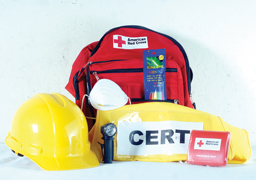Kit, planning and information can keep individuals safe
When it comes to emergency preparedness at home, most emergency
services officials list three things as the key to prepping one’s
family for disaster: get a kit, make a plan and be informed.
”
They should have a supply of the usual stuff,
”
said James Clark, the office of emergency services manager for
San Benito County.
”
All the essentials like food and water, for five days. They
should be prepared to camp out
…They should have a family emergency plan in place for if it
happens when kids are in school.
”
Kit, planning and information can keep individuals safe
When it comes to emergency preparedness at home, most emergency services officials list three things as the key to prepping one’s family for disaster: get a kit, make a plan and be informed.
“They should have a supply of the usual stuff,” said James Clark, the office of emergency services manager for San Benito County. “All the essentials like food and water, for five days. They should be prepared to camp out …They should have a family emergency plan in place for if it happens when kids are in school.”
Patsy Hernandez, the emergency services manager for the American Red Cross Santa Cruz chapter that services San Benito, agreed.
“People should get a kit, make a first-aid kit and a preparedness kit with disaster supplies,” Hernandez said. “It should be something that is easy to carry. In Santa Cruz, I show them a garbage can on wheels. Once it is fully loaded, they are really heavy.”
Hernandez lists flashlights, with the batteries taped to the outside so they don’t corrode high up on the supply list, as well as a seven-day supply of medication, and photocopies of important documents in a Ziplock bag. Clark also suggested having some cash on hand, since ATMs might be down and banks closed.
Hernandez said the number one obstacle she hears from families about putting together an emergency kit is the cost.
“They think it is overwhelming,” she said. “But if you prepare on a weekly basis or once a month, putting a little aside each time you grocery shop – a couple cans here, a couple cans there – and there is a lot of stuff around the house. It shouldn’t really cost a lot.”
She said families may find they have many of the items needed around the house such as old blankets, flashlights and batteries. They can also include items for pets if they need to shelter in place.
“If you do it as a family event, looking for these items and putting it together, everyone is really familiar with what is in the kit,” Hernandez said.
The second part of preparing is putting together a plan. Both Clark and Hernandez suggest families have a contact outside the state with whom individuals can check in since local phone lines might be down or overloaded.
“Make a plan about where the family will meet,” Hernandez said. “When [kids] come home from school, who is the contact they should let know they are okay?”
The American Red Cross also has a Safe and Well Web site where people can register during a disaster to let family members know they are okay (https://disastersafe.redcross.org). Families in San Benito County also can register with the county’s “Connect-CTY,” a county-to-resident notification system that may be used in emergencies. Residents can register with a phone number or e-mail address online at www.san-benito.ca.us/connectcty.html.
The last key to being prepared is being informed. Hernandez expressed the importance of understanding the types of disasters that are likely near one’s home or work place, whether it be earthquake, fire, flood or other events.
Hernandez stressed that drilling the family to make sure the plan works is also important.
“Drill your family on ways to get in and out,” Hernandez said. “Work on what you will do if you have to shelter in place.”
In addition to the kits and planning, Hernandez said the American Red Cross suggests that people be trained in First Aid and CPR.
“In an emergency, a lot of first responders will be tied up,” Hernandez said.
One thing she has planned since she took over Red Cross emergency services for San Benito County on Sept. 1 is recruiting more volunteers who could respond to a major disaster or smaller emergencies such as a house fire.
“We have 600 volunteers trained in Santa Cruz,” Hernandez said. “We are always looking for volunteers, especially bilingual volunteers.”
Volunteers are required to pass a criminal background check that is free to them, and they can receive training on a variety of emergency topics that will prepare them to respond to local and national emergencies.
The Red Cross also provides information on how families can prepare for an emergency and sells a variety of emergency preparedness starter kits online.
Create an emergency kit
Basic supplies
Water – one gallon per person, per day (three-day supply for evacuation, two-week supply for home)
Food – non-perishable, easy-to -prepare items (three-day supply for evacuation, two-week supply for home)
Flashlight
Battery-powered or hand-crank radio (NOAA Weather Radio, if possible)
Extra batteries
First aid kit
Medications (seven-day supply) and medical items
Multi-purpose tool
Sanitation and personal hygiene items
Copies of personal documents (medication list and pertinent medical information, proof of address, deed/lease to home, passports, birth certificates, insurance policies) in water proof bag, such as a Ziplock bag
Cell phone with chargers
Family and emergency contact information
Extra cash
Emergency blanket
Map(s) of the area
Consider the needs of all family members and add supplies to your kit. Suggested items to help meet additional needs are:
Medical supplies (hearing aids with extra batteries, glasses, contact lenses, syringes, cane)
Baby supplies (bottles, formula, baby food, diapers)
Games and activities for children
Pet supplies (collar, leash, ID, food, carrier, bowl)
Two-way radios
Extra set of car keys and house keys
Manual can opener
Additional supplies to keep at home or in your kit based on the types of disasters common to your area:
Whistle
N95 or surgical masks
Matches
Rain gear
Towels
Work gloves
Tools/supplies for securing your home
Extra clothing, hat and sturdy shoes
Plastic sheeting
Duct tape
Scissors
Household liquid bleach
Entertainment items
Blankets or sleeping bags
List courtesy of the American Red Cross, www.redcross.org.










